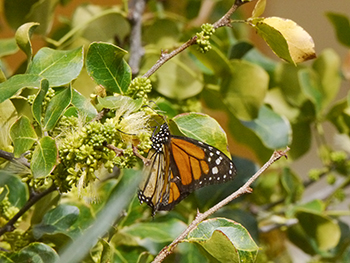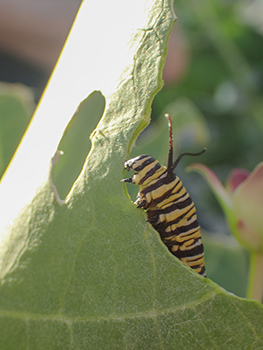This post is also available in: Dutch (below)
All wildlife has many life phases. Some start as a tiny egg incubated outside (and sometimes insides) a mothers body, and in the case of Seahorses in a pouch of the fathers body. Others are born from the womb of their mother. And others are born from a separated piece of an adult life stage. This series puts the spotlight on a variety of species of wildlife on our islands with photos of the young or immature life stage together with the adult stage.
Monarch butterflies
There is almost no greater difference between young and adult stages as there is in the taxonomic class of insects. Butterflies are often the most ‘in your face’ example of this fact. Take Monarch butterflies for instance.
Monarch butterflies may be the most popular butterfly species that graces the islands. Of course these large butterflies, they can be about 9,5 cm from wing tip to wing tip, are very colourful with their orange, black and white patterns and easy to observe. Not only do they occur all over the islands, but they are also particularly abundant in urban areas and gardens, thanks to the fact that their Giant milkweed host plant (Katuna di seda, Calotropis procera) grows particularly well in urban areas. Their easy going almost slow flying behaviour makes that most people will not get alarmed when the flying insects comes near.
Many people are under the false impression that the Monarch butterflies on Aruba, Bonaire and Curaçao are part of the huge flocks of Monarchs that are famous for their migratory behaviour from the United States of America to Mexico and back. However that is not the case. The Monarch butterflies that live on the ABC-islands are part of a south Caribbean sub-group of butterflies that are also slightly smaller than their North American family members and have different patterns on the wings.
Young and adult


The caterpillars of this species are in stark contrast with their adult stage. The caterpillars are bright yellow with contrasting black and yellow stripes. This signals to potential predators that they are toxic and it is better not to consume them. Most birds will leave them alone. One of the few birds that eats them anyway is the Yellow-billed cuckoo, a migratory bird that can be found during fall and spring migration.
Publications used:
- Debrot, A.O. & Miller, J.Y. 2004. Butterflies and moths of Curaçao, Aruba and Bonaire. 1-100. CARMABI Foundation, Willemstad.
- Dutch Caribbean Species Register
- Bugguide.net
- Junonia neildi Brévignon, 2004
English name: Monarch butterfly
Papiamentu name: Barbulètè Monarka (Curaçao), Monarka
Scientific name: Danaus plexippus (megalippe)
Family: Nymphalidae (brush-footed butterflies or four-footed butterflies)
Occurrence (ABC islands): Curaçao, Bonaire and Aruba

Jong en volwassen – De Monarchvlinder
Alle wilde dieren kennen verschillende levensfasen. Sommige beginnen als een klein eitje dat buiten (en soms in) het lichaam van de moeder wordt uitgebroed, en in het geval van zeepaardjes in een buidel van het lichaam van de vader. Andere worden geboren uit de baarmoeder van hun moeder. En weer andere worden geboren uit een apart stukje van een volwassen levensfase. Deze serie belicht een verscheidenheid aan diersoorten op onze eilanden met foto’s van de jonge of onvolwassen levensfase samen met de volwassen fase.
Monarchvlinder
Er is bijna geen groter verschil tussen jonge en volwassen stadia dan in de taxonomische klasse van insecten. Vlinders zijn vaak het meest opvallende voorbeeld hiervan. Neem bijvoorbeeld de Monarchvlinder.
Monarchvlinders zijn misschien wel de populairste vlindersoort op de eilanden. Natuurlijk zijn de grote vlinders, die van vleugelpunt tot vleugelpunt ongeveer 9,5 cm groot kunnen zijn, zeer kleurrijk met hun oranje, zwart-witte patronen en gemakkelijk te observeren. Ze komen niet alleen overal op de eilanden voor, maar zijn ook bijzonder talrijk in stedelijke gebieden en tuinen, dankzij het feit dat hun waardplant, de Katuna di seda (Calotropis procera), bijzonder goed groeit in stedelijke gebieden. Hun rustige, bijna langzame vlieggedrag zorgt ervoor dat de meeste mensen niet schrikken als de vliegende insecten in de buurt komen.
Veel mensen denken ten onrechte dat de Monarchvlinders op Aruba, Bonaire en Curaçao deel uitmaken van de enorme zwermen monarchvlinders die beroemd zijn om hun trekgedrag van de Verenigde Staten naar Mexico en terug. Dat is echter niet het geval. De monarchvlinders die op de ABC-eilanden leven, maken deel uit van een subgroep vlinders in het Zuid-Caribisch gebied. Deze vlinders zijn ook iets kleiner dan hun Noord-Amerikaanse familieleden en hebben andere patronen op de vleugels.
Jong en volwassen


De rupsen van deze soort contrasteren sterk met hun volwassen stadium. De rupsen zijn felgeel met contrasterende zwarte en gele strepen. Dit geeft potentiële roofdieren het signaal dat ze giftig zijn en dat ze beter niet gegeten kunnen worden. De meeste vogels laten ze met rust. Een van de weinige vogels die ze toch eet, is de geelbekkoekoek, een trekvogel die te vinden is tijdens de herfst- en voorjaarstrek.
Gebruikte literatuur:
- Debrot, A.O. & Miller, J.Y. 2004. Butterflies and moths of Curaçao, Aruba and Bonaire. 1-100. CARMABI Foundation, Willemstad.
- Dutch Caribbean Species Register
- Bugguide.net
- Junonia neildi Brévignon, 2004
Nederlandse naam: Monarchvlinder
Papiamentse naam: Barbulètè Monarka (Curaçao), Monarka
Wetenschappelijke naam: Danaus plexippus (megalippe)
Familie: Nymphalidae (schoenlappers, parelmoervlinders en zandoogjes )
Voorkomen (ABC eilanden): Curaçao, Bonaire en Aruba